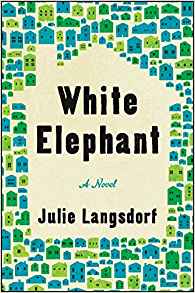The underside of suburban politics is given dimension in this absorbing debut.

My wife and I spent our first year of marriage in an apartment and then decided to make the big leap and buy a house. It was a little bungalow in a somewhat threadbare Virginia suburb south of Washington, DC, where all the streets were named for universities.
Built in the 1950s, the development was unapologetically elitist in its designs. The nicer streets were named for Ivy League schools; the lesser, which were crowded with duplexes on smaller lots, were — yikes — named for women’s colleges.
Everyone would know their place, the builders must have thought, and we knew ours: We lived on Cornell, which wasn’t nearly so nice as Princeton. When someone knocked down a house nearby to build something newer and bigger and nicer, we were thrilled. Maybe our humble street would upend the order yet.
Upending all kinds of order lies at the heart of Julie Langsdorf’s merry first novel, White Elephant, which takes place in Willard Park, another leafy DC suburb. Her Willard Park is fictional, but only slightly; anyone who knows DC will be able to pinpoint its location with Google Maps-like precision.
And, here, the arrival of a developer bent on tearing down old houses like ours and building McMansions in their place isn’t welcomed but scorned. The streets aren’t named for colleges, but they might as well be: A deep (and deeply contentious) social code rules this suburb.
Three couples orbit at the nucleus of the novel: longtime residents Allison and Ted Miller; arriviste developer Nick Cox and his wife, Kaye; and another new arrival, type-A Suzanne and her attorney husband, Grant, a cannabis aficionado who’s nevertheless sworn off the stuff — at least until life gets too complicated and stressful, which it rapidly does for him and everyone else in the book.
When Nick cuts down a red maple belonging to the Millers, Ted starts a grassroots campaign to save future trees — and historic houses — from similar destruction. Suzanne and Grant become pregnant, but health issues ensue (which would be problem enough, but then their son begins experiencing mysterious aches and pains, too).
And then there’s the Millers. Not only are they dealing with the loss of that tree, but also the loss of their sex life. Not for nothing does this novel memorably begin: “Allison Miller lay in bed in the dim light of early morning thinking about sex.”
If it all sounds a bit overstuffed, it is, only happily so. This is the messy, tumultuous stuff of real life, at least as lived in claustrophobically tidy suburbs, where everyone is deeply involved in everyone else’s business.
One of the things that Langsdorf does particularly well is show how interconnected such lives inescapably are. The Millers and the Coxes quickly become blood enemies, for example. But their children attend the same school, a friendship (albeit an uncomfortable one) results, and loyalties are tested at every level. And Allison: No book worth its (high-end, organic, large-flake) salt wouldn’t somehow address that thought which greeted her and the reader on page one.
The point-of-view shifts deftly throughout the story, but the book’s and reader’s sympathies remain steadily with Allison, whose vocation — photography — is a good metaphor for what’s happening in Willard Park. Everyone is constantly eyeing everyone else, arranging and rearranging compositions until they make sense.
No one does this more thoroughly than Allison, and the book is careful not to present her, nor any other character, as being above it all. Indeed, Allison’s gaze is most unsparing when it’s directed inward.
A photography major in college and a gallery manager after, she’s now shooting portraits for her neighbors; nothing more, she thinks, than “oversized snapshots [that] stared out at her accusingly whenever she entered one of her clients’ homes, reminding her that she’d sold out.”
But she hasn’t. No one here has. Book clubs will have a lot of fun arguing over this point and, perhaps, a lot of uneasy fun identifying with the various personalities portrayed in its pages.
Author Julie Langsdorf’s greatest achievement in White Elephant is to simultaneously play with caricatures while also exploding them. Everyone in this book is treated to a thoughtful, well-rounded portrait. Much in this novel is oversized, including the house whose nickname gives the story its title, but the measure it takes of various hearts is not, rendered as they are on a deeply human scale.
[Editor's note: Julie Langsdorf will appear at this year's Gaithersburg Book Festival on May 18th in Olde Towne Gaithersburg, MD. Click here for a full schedule of events.]
Liam Callanan’s work has been longlisted for the 2019 Simpson Literary Prize. His most recent novel is Paris by the Book.

